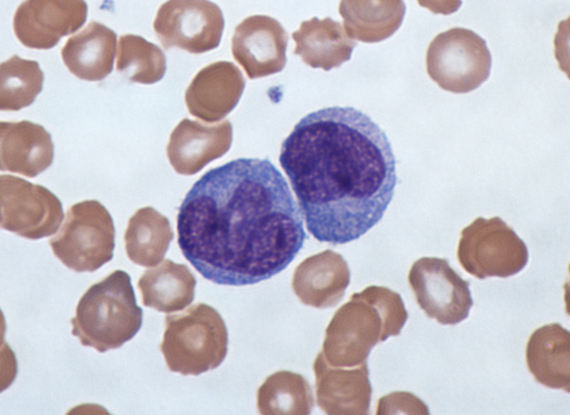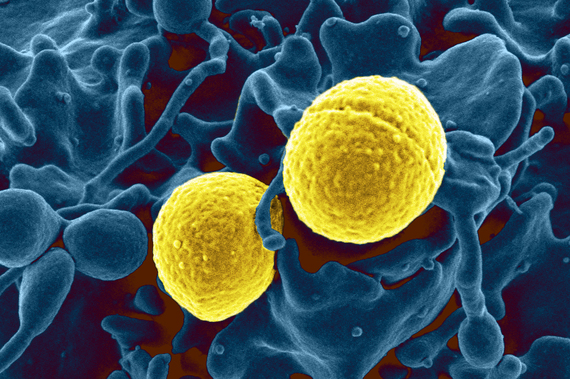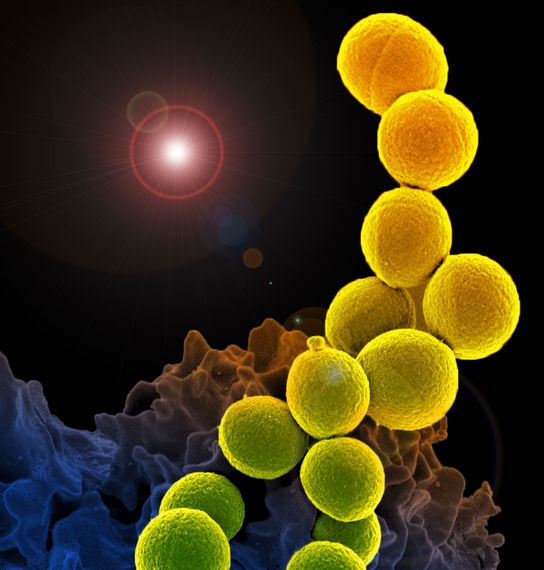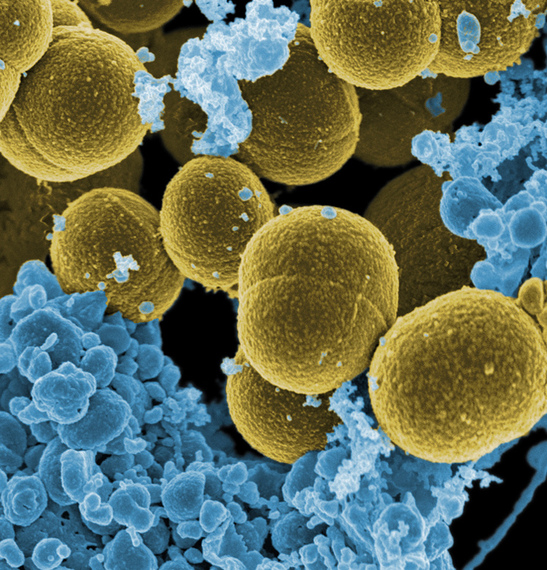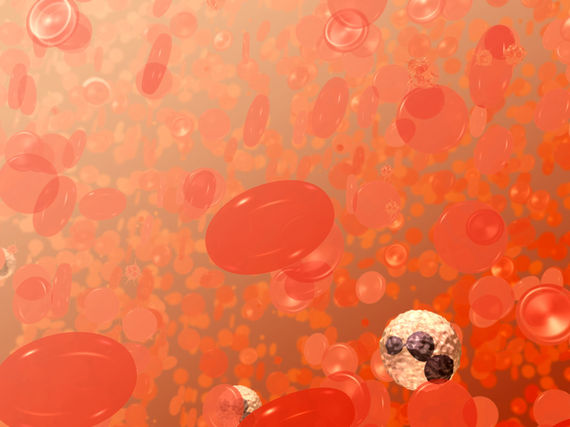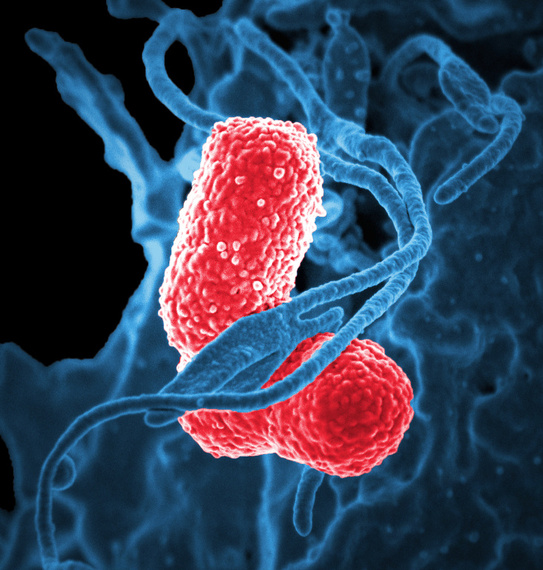CLEVELAND CLINIC: Goodyear Satire Company --
A reader writes, "Dr. GOP, how can the Republican Party fight off its persistent Donald Trump infection?"
The Donald Trump infection is a relatively new strain of superbug called trumpococcus teapartius. It is highly resistant to antibiotics or reason, so the body politic must rely on its white cells to fight off the infection.
There are several types of white cells. They include Christies, Rubios, Bushes, Cruzes, Romneys and Pauls. Each fights infection in a different way.
Christies are one of the body politic's main defenses against bacteria. Christies kill bacteria by ingesting them. In the event the invader is too strong, Christies can absorb the invader's DNA, turn against the body and support the infection. Scientists have observed Christies in the wild shining the shoes of the successful invader in its own quest for power and food.
Another type of white cell is called a Rubio. Rubios are immature Christies. Rubios and Christies sometimes attack each other. Christies typically best Rubios, expeling them from the body politic, and sending them home to Florida to nurse their wounds. Through exposure to sunlight, the Rubios' store of Vitamin D is replenished. Then they can join the Christies to further encourage the invader. A Secretary of Education Marco Rubio may result.
The Bush type of white cell kills parasites. Hematologists have identified a family of related Bush cells including Jebs, Georges and Old Georges. Jebs are not as effective in repelling invasions as Georges or Old Georges. and are impotent in the face of a strong or persistent infection. Jebs appear to commit cellicide and remove themselves from circulation. It is unknown what happens to them after they write their memoirs. Please clap.
Although Cruzes are not well understood, they also function in allergic reactions. Cruzes release histamine (which attracts renegade white cells) and heparin (which prevents clotting). Their freedom to associate thus challenged, Cruzes cling to their guns, wither and die as an effective infection-fighting force.
Romneys enter the tissue itself, where they become 47% larger. There they can ingest bacteria throughout the body. Romneys destroy damaged and dead cells and send their jobs to China.
Christies and Romneys use many mechanisms to get to and kill invading organisms. Both can squeeze through tiny openings in debates. They are attracted to chemicals produced by the immune system or residue found on twenty dollar bills. They kill bacteria by completely surrounding the bacteria and digesting them with enzymes.
If they fail to kill the bacteria, the bacteria develops immunity to all types of white cells except Klans and Neos. These are white cells that encourage, rather than discourage, infection and chaos.
The trumpococcus teapartius infection takes over in the absence of a strong challenge from the body's establishment. The infection effectively destroys the body politic, reducing its institutional legacy to tatters.
This can only happen if the established white cells allow the body to be corrupted. The Romneys, Cruzes and their helper cells the Ryans join the Christies and Rubios and all mistakenly support the invader by attacking a common foe, when the real enemy to the viability of the body is the invader itself.
After four years of a Donald Trump infection, the GOP establishment will no longer exist.
Pauls are complex cells used to direct the body's immune system. White cells called Pauls come in two types, Ronocytes (called R cells) and Randocytes (called D cells). The D cells lose power rather quickly.
When both R and D cells are depleted, Independent Johnsons emerge and quickly become the established cells' preferred method of reasserting systemic control.Independent Johnsons challenge the invader, finally vanquishing it and rebranding the Independent Johnson as the body politic. Thus, the body controls the infection and the invader is reduced to filing bankruptcy to wipe out his campaign debt.
An alternative strategy is to encourage the growth of a strain of helper enzymes called democratus partius, either a Hillarius or Bernius. Either can defeat the trumpococcus teapartius by a reduction in conversations about the damn emails and actually discussing policy and goals. Hillarius enzymes tend to express attitudes and display behavior similar to Romnies without penii. On the other hand, Bernius tends to exhibit the same spirit as Independent Johnsons but on a wider range of social issues. His earlier writings displayed a fondness for independent johnsons.
Thanks for your great question!
Dr. GOP
Photo credits:
Monocytes, a type of white blood cell (Giemsa stained).jpg https://commons.wikimedia.org/wiki/File%3AMonocytes%2C_a_type_of_white_blood_cell_(Giemsa_stained).jpg By Dr Graham Beards [CC BY-SA 3.0 (http://creativecommons.org/licenses/by-sa/3.0)], via Wikimedia Commons
Staph aureus outside a white blood cell https://commons.wikimedia.org/wiki/File%3AStaph_aureus_outside_a_white_blood_cell.jpg By National Institutes of Health (NIH) (National Institutes of Health (NIH)) [Public domain], via Wikimedia Commons
Red, White Blood cells.jpg https://commons.wikimedia.org/wiki/File%3ARed_White_Blood_cells.jpg By Electron Microscopy Facility at The National Cancer Institute at Frederick (NCI-Frederick) ([1]) [Public domain], via Wikimedia Commons
White blood cell with MRSA.jpg https://commons.wikimedia.org/wiki/File%3AWhite_blood_cell_with_MRSA.jpg By National Institutes of Health (NIH) (National Institutes of Health (NIH)) [Public domain], via Wikimedia Commons
Blood cells 090304-F-5951M-108.jpg https://commons.wikimedia.org/wiki/File%3ABlood_cells_090304-F-5951M-108.jpg By U.S. Air Force photo/Airman 1st Class Laura Max. [Public domain], via Wikimedia Commons
Staphylococcus aureus bacteria escape.jpg https://commons.wikimedia.org/wiki/File%3AStaphylococcus_aureus_bacteria_escape.jpg By =(Credit: NIAID/RML) [Public domain], via Wikimedia Commons
Red blood cells illustration.jpg https://commons.wikimedia.org/wiki/File%3ARed_blood_cells_illustration.jpg By Donald Bliss (Illustrator) [Public domain or Public domain], via Wikimedia Commons
Multidrug-resistant Klebsiella pneumoniaeand neutrophil.bmp.jpg https://commons.wikimedia.org/wiki/File%3AMultidrug-resistant_Klebsiella_pneumoniaeand_neutrophil.bmp.jpg By David Dorward; Ph.D.; National Institute of Allergy and Infectious Diseases (http://phil.cdc.gov/phil/details.asp) [Public domain], via Wikimedia Commons
